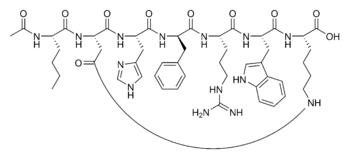Bremelanotide
From Wikipedia, the free encyclopedia
 |
|
|
Bremelanotide
|
|
| Systematic (IUPAC) name | |
| (3R,6R,9S,12R,15R,23R)-15-{[(2R)-2-
Acetamidohexanoyl]amino}-9-benzyl- 6-(3-carbamimidamidopropyl)-12- (1H-imidazol-5-ylmethyl)-3-(1H-indol- 3-ylmethyl)-2,5,8,11,14,17-hexaoxo- 1,4,7,10,13,18-hexaazacyclotricosane -23-carboxylic acid |
|
| Identifiers | |
| CAS number | |
| ATC code | ? |
| PubChem | |
| Chemical data | |
| Formula | C50H68N14O10 |
| Mol. mass | 1025.2 |
| SMILES | & |
| Pharmacokinetic data | |
| Bioavailability | ? |
| Metabolism | ? |
| Half life | ? |
| Excretion | ? |
| Therapeutic considerations | |
| Pregnancy cat. |
? |
| Legal status |
?(US) |
| Routes | ? |
Bremelanotide (pronounced /brɛ ˌmɛ læ noʊ ˈtаɪd/ ![]() bremelanotide (help·info)) (formerly PT-141) is a compound under drug development by Palatin Technologies as a treatment for hemorrhagic shock and reperfusion injury. It functions by activating the melanocortin receptors MC1R and MC4R, to modulate inflammation and limiting ischemia. [1] It was originally developed for use in treating sexual dysfunction but this application was discontinued in 2008, after concerns were raised over adverse side effects of increased blood pressure.
bremelanotide (help·info)) (formerly PT-141) is a compound under drug development by Palatin Technologies as a treatment for hemorrhagic shock and reperfusion injury. It functions by activating the melanocortin receptors MC1R and MC4R, to modulate inflammation and limiting ischemia. [1] It was originally developed for use in treating sexual dysfunction but this application was discontinued in 2008, after concerns were raised over adverse side effects of increased blood pressure.
Contents |
[edit] Development
Originally, the peptide Melanotan II, that bremelanotide was developed from, was tested as a sunless tanning agent. In initial testing, Melanotan II did induce tanning but additionally caused sexual arousal and spontaneous erections as unexpected side effects in nine out of the ten original male volunteer test subjects.[2]
In studies, bremelanotide was shown to induce lordosis in an animal model [3] and be effective in treating sexual dysfunction in both men (erectile dysfunction or impotence) and women (sexual arousal disorder). Unlike Viagra and other related medications, it does not act upon the vascular system, but directly increases sexual desire via the nervous system. [4]
A Phase III clinical trial was scheduled to begin in the first half of 2007, but was delayed until August 2007. On August 30, Palatin announced that the U.S. Food and Drug Administration had expressed serious concerns regarding the risk/benefit ratio of bremelanotide with regards to the side effect of increased blood pressure. The FDA stated that they would consider alternate uses for bremelanotide, including as a treatment for individuals who do not respond to more established ED treatments. However, On May 13, 2008, Palatin Technologies announced it "has discontinued development of Bremelanotide for the treatment of male and female sexual dysfunction" however they concurrently announced plans to develop it as a treatment for hemorrhagic shock instead. [5] The company additionally announced intentions to focus its attention on another compound, PL-6983, that causes lower blood pressure in animal models. [6]
[edit] Structure
Bremelanotide is a cyclic hepta-peptide lactam analog of alpha-melanocyte-stimulating hormone (alpha-MSH) that activates the melanocortin receptors MC3-R and MC4-R in the central nervous system. It has the amino acid sequence Ac-Nle-cyclo[Asp-His-D-Phe-Arg-Trp-Lys]-OH or cyclo-[Nle4, Asp5, D-Phe7, Lys10]alpha-MSH-(4-10). It is a metabolite of Melanotan II that lacks the C-terminal amide function.
[edit] See also
[edit] References
- ^ Bremelanotide for Organ Protection and Related Indications, Palatin Technologies fact sheet. Retrieved on 2009-01-18.
- ^ "Tanning drug may find new life as Viagra alternative" (HTML). CNN. 1999. http://www.cnn.com/HEALTH/men/9906/17/viagra.alternative/. Retrieved on 2007-09-16.
- ^ Pfaus JG, Shadiack A, Van Soest T, Tse M, Molinoff P (July 2004). "Selective facilitation of sexual solicitation in the female rat by a melanocortin receptor agonist". Proc. Natl. Acad. Sci. U.S.A. 101 (27): 10201–4. doi:. PMID 15226502.
- ^ Vicki Mabrey (2006). "ABC News "The Business of Desire - Love Potion"" (HTML, Flash Video). ABC News. http://abcnews.go.com/Video/playerIndex?id=2712896. Retrieved on 2009-01-24.
- ^ "Palatin Technologies announces new strategic objectives and reports third quarter 2008 financial results" (HTML). Palatin Technologies press release. 2008. http://palatin.com/news/news.asp?param=202. Retrieved on 2008-08-21.
- ^ "Palatin Technologies Announces New Strategic Objectives". http://palatin.com/news/news.asp?ID=201. Retrieved on 2008-05-13.
[edit] External links
- Palatin Technologies The company that has developed bremelanotide.
- US 6,794,489 bremelanotide (PT-141) patent (Appl. No.:040547)
- US 6,579,968 bremelanotide (PT-141) patent (Appl. No.:066501)
- Melanotan.org
|
||||||||||||||

